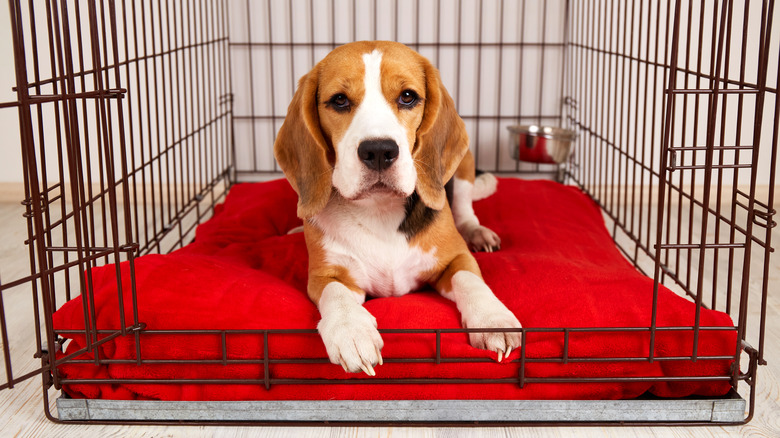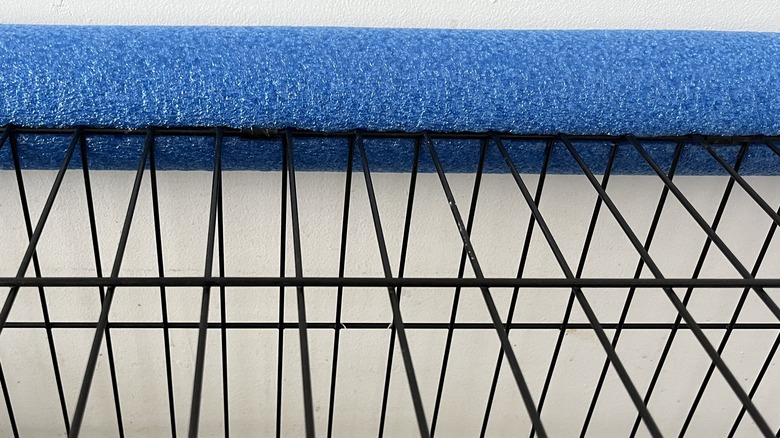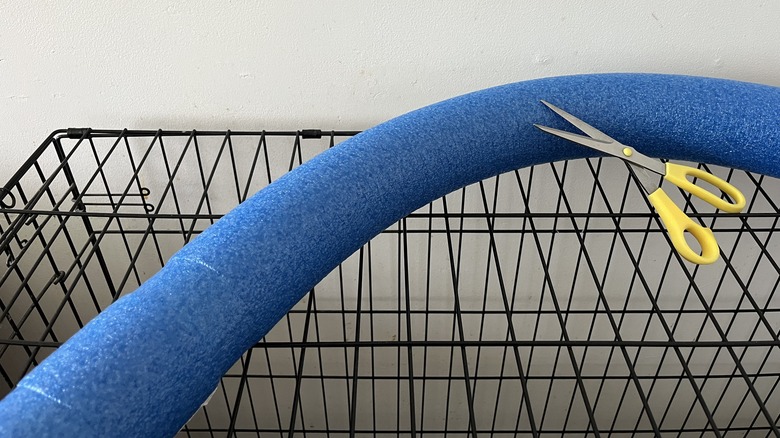The Pool Noodle Hack That Prevents Dog Crates From Scratching Up Your Walls
Pets are part of the family, so of course their comfort is important. According to the American Kennel Club, a crate is a beneficial tool for dogs of all ages for training, shelter, and a feeling of security. Some dogs love their crates and seek them out as a safe space during storms, fireworks, or other events they may be frightened by. While travel kennels are made of plastic, home crates are made of metal. The metal siding is sturdy but can be a nuisance for your paint or wallpaper. If your dog moves around a lot or runs in and out, the metal could rub against your walls. Fortunately, it's easy to protect your paint with a pool noodle and some ingenuity.
The pool noodle we know and love today has a surprisingly wide range of purposes. It was originally used as a backer rod (a foam tube for sealing joints) in construction projects. When David Hartman brought home some of these 9-foot foam rods in the late 1990s, his son Steve had other ideas and popped them into the family pool. Voila, the pool noodle was born. Through the years, it continues to evolve, and there are a variety of genius pool noodle hacks you should be using in your home and garden. One such hack involves attaching it to a dog crate to create a buffer between the crate and the wall. Check out this simple foam fix for keeping your walls free of dents and scratches caused by your dog's crate.
Why the pool noodle is the optimal choice for this dog crate DIY
One of the pool noodle hacks that is a must-try if you have pets is the wall buffer. The main reason foam swim rods are the perfect choice for this project is because they are cheap and easy to install. While you could purchase a pet wall shield from places like Home Depot, you'll wind up paying around $180 for 50 feet of material and need to trim and install the shield with the included hardware. Instead, pick up a 54-inch noodle at your local Dollar Tree for only $1.25, and simply slide the foam on and off as needed. Another reason these swim toys work well on a pet crate is because they repel moisture.
Pool noodles are typically made of polyethylene foam, which is lightweight and waterproof, helping them stay in place, and reducing the risk of water transfer onto your walls. Polyethylene is a closed-cell foam, meaning there aren't tiny holes in it and it won't absorb moisture in the air the way some open-cell foams might. This makes it less susceptible to bacteria and mildew, which nobody wants near their pets. Now that we have the why of it out of the way, let's get into the how.
Create your own pool noodle wall buffers
To make this project at home you'll need one pool noodle and a pair of scissors. Measure the side of the kennel touching the wall(s) and trim the noodle to fit. Now, slice one side of the noodle on its longest side so you can open it. Here's where things get tricky. If the crate has a single bar across the top, simply slip the foam on. If the crate has a top bar joined by multiple vertical bars you'll need to make adjustments. Rest the noodle against the crate and draw a line where each of the bars meet the foam. Cut about 1 inch into the foam everywhere a bar intersects it. The noodle should now slip on with a little fine-tuning.
It's good to note how your dog feels with this addition to their crate, as not every dog owner will find this hack handy. Like all the products introduced to your pup, it's good to take personality and temperament into account before adding buffers. If your dog is known to chew things within reach or gets spooked by foreign objects in their crate, you may need to seek an alternative. Otherwise, you can keep your home stylish when you have pets by displaying scratch-free walls with your new pool noodle crate buffers.


